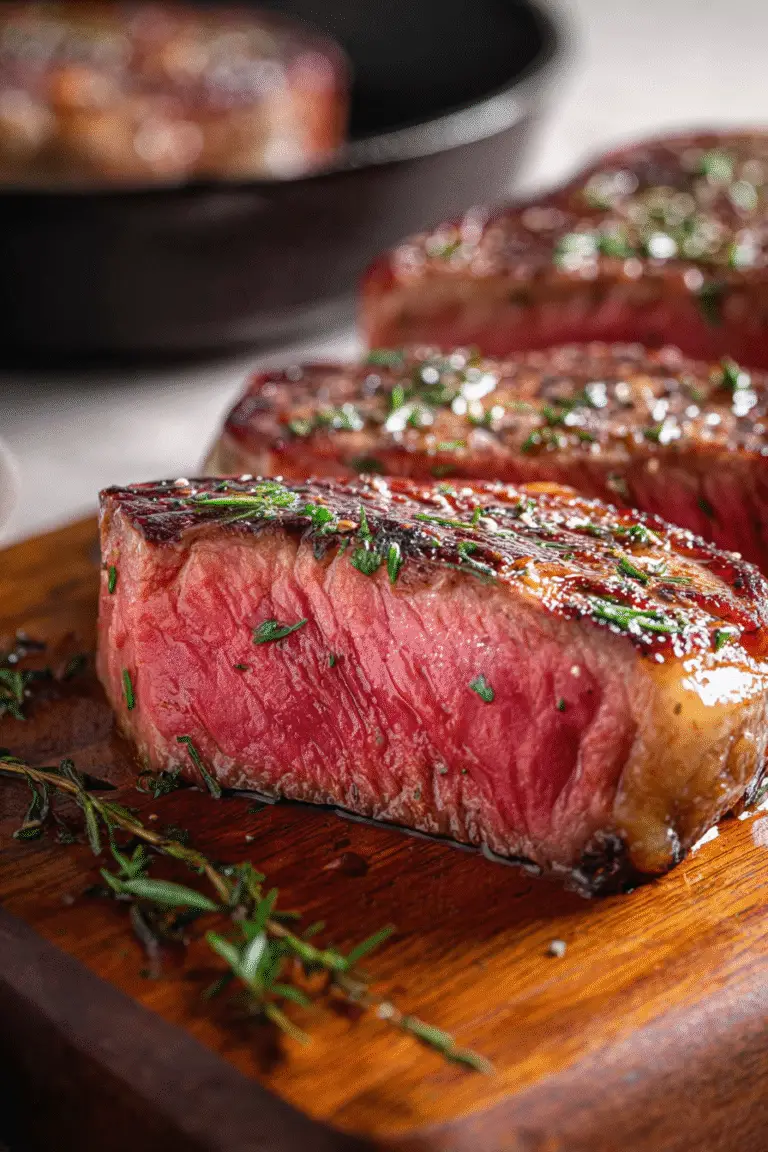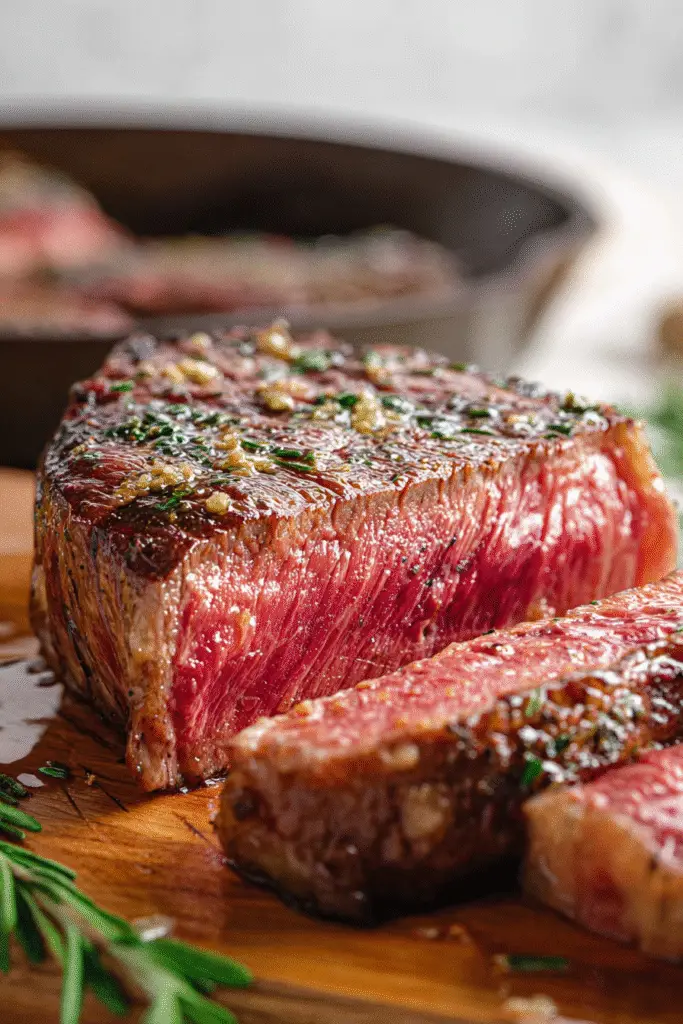Introduction
Few cuts of beef inspire as much excitement as the ribeye steak. Known for its incredible marbling, deep beefy flavor, and melt-in-your-mouth tenderness, ribeye is often called the king of steaks.
Print
Ribeye – The Juiciest Steak You’ll Ever Cook
This ribeye steak recipe delivers a juicy, flavorful cut seared to perfection with garlic and herbs. The tender inside and golden crust make it a true steakhouse experience at home. Perfect for weeknight indulgence or special occasions — try it today and impress your taste buds!
- Total Time: 25 minutes
- Yield: 2
Ingredients
2 ribeye steaks (about 1 ¼–1 ½ inches thick, ~12 oz each)
2 tbsp olive oil or avocado oil
3 tbsp unsalted butter
4 garlic cloves, smashed
2 sprigs fresh rosemary (or thyme)
1 tsp kosher salt (adjust to taste)
½ tsp freshly ground black pepper
Optional: flaky sea salt for finishing
Instructions
Prepare Steaks: Pat the ribeye steaks dry with paper towels. Season generously with salt and black pepper on both sides.
Preheat Pan: Heat a large cast-iron skillet over high heat until very hot. Add olive oil and swirl to coat.
Sear the Ribeye: Place the steaks in the hot skillet and sear for 2–3 minutes per side until a golden-brown crust forms.
Add Flavor: Reduce heat to medium. Add butter, garlic cloves, and rosemary sprigs. Tilt the pan and spoon the melted butter over the steaks continuously for 1–2 minutes.
Check Doneness: Use a meat thermometer — 125°F (rare), 135°F (medium-rare), 145°F (medium). Remove steaks about 5°F before your target temp as they continue cooking off the heat.
Rest and Serve: Transfer steaks to a cutting board. Let rest for 5–7 minutes before slicing against the grain. Finish with flaky sea salt if desired.
Notes
For the best crust, ensure your skillet is very hot before adding the steaks.
Let the ribeye rest at room temperature for 30 minutes before cooking for even doneness.
Always use a meat thermometer for accuracy. Overcooking ribeye can make it tough.
Pair with mashed potatoes, roasted vegetables, or a fresh salad for a balanced meal.
- Prep Time: 10 minutes
- Cook Time: 15 minutes
- Category: Main Course
- Method: Pan-Seared, Cast-Iron Skillet
- Cuisine: American, Steakhouse
- Diet: Gluten Free

Ribeye – The Juiciest Steak You’ll Ever Cook
This ribeye steak recipe delivers a juicy, flavorful cut seared to perfection with garlic and herbs. The tender inside and golden crust make it a true steakhouse experience at home. Perfect for weeknight indulgence or special occasions — try it today and impress your taste buds!
- Total Time: 25 minutes
- Yield: 2
Ingredients
2 ribeye steaks (about 1 ¼–1 ½ inches thick, ~12 oz each)
2 tbsp olive oil or avocado oil
3 tbsp unsalted butter
4 garlic cloves, smashed
2 sprigs fresh rosemary (or thyme)
1 tsp kosher salt (adjust to taste)
½ tsp freshly ground black pepper
Optional: flaky sea salt for finishing
Instructions
Prepare Steaks: Pat the ribeye steaks dry with paper towels. Season generously with salt and black pepper on both sides.
Preheat Pan: Heat a large cast-iron skillet over high heat until very hot. Add olive oil and swirl to coat.
Sear the Ribeye: Place the steaks in the hot skillet and sear for 2–3 minutes per side until a golden-brown crust forms.
Add Flavor: Reduce heat to medium. Add butter, garlic cloves, and rosemary sprigs. Tilt the pan and spoon the melted butter over the steaks continuously for 1–2 minutes.
Check Doneness: Use a meat thermometer — 125°F (rare), 135°F (medium-rare), 145°F (medium). Remove steaks about 5°F before your target temp as they continue cooking off the heat.
Rest and Serve: Transfer steaks to a cutting board. Let rest for 5–7 minutes before slicing against the grain. Finish with flaky sea salt if desired.
Notes
For the best crust, ensure your skillet is very hot before adding the steaks.
Let the ribeye rest at room temperature for 30 minutes before cooking for even doneness.
Always use a meat thermometer for accuracy. Overcooking ribeye can make it tough.
Pair with mashed potatoes, roasted vegetables, or a fresh salad for a balanced meal.
- Prep Time: 10 minutes
- Cook Time: 15 minutes
- Category: Main Course
- Method: Pan-Seared, Cast-Iron Skillet
- Cuisine: American, Steakhouse
- Diet: Gluten Free
Whether seared in a cast-iron skillet, grilled over smoky charcoal, or finished in the oven, ribeye delivers a restaurant-quality dining experience right at home.
In this recipe, you’ll learn everything about making the perfect ribeye: how to choose the right cut, what ingredients enhance its natural richness, and a step-by-step guide to cooking it flawlessly.
Beyond the recipe, you’ll also find useful notes on side pairings, common mistakes to avoid, and answers to frequently asked questions.
By the end, you’ll not only master a foolproof ribeye steak recipe but also understand why this cut is celebrated across the United States as a true steakhouse classic.
Ingredients for Ribeye Steak
- 2 ribeye steaks (about 1–1.5 inches thick, bone-in or boneless, 12–16 oz each)
- 2 tablespoons olive oil (or avocado oil for higher smoke point)
- 2 teaspoons kosher salt (adjust to taste)
- 1 teaspoon freshly ground black pepper
- 3 garlic cloves, smashed
- 3 tablespoons unsalted butter
- 2 sprigs fresh rosemary (or thyme)
- Optional finishing touch: flaky sea salt
Step-by-Step Instructions
Step 1: Choose Your Ribeye
Start by selecting well-marbled ribeye steaks. Marbling refers to the thin white streaks of fat running through the meat, which melt during cooking and create juiciness. A thicker steak (at least 1 inch) gives you better control over doneness.
Step 2: Bring to Room Temperature
Take the steaks out of the fridge about 30 minutes before cooking. Allowing ribeye to reach room temperature ensures even cooking from edge to center.
Step 3: Season Generously
Pat the steaks dry with paper towels. Coat lightly with olive oil, then season all sides with kosher salt and black pepper. Don’t be shy—ribeye loves bold seasoning.
Step 4: Preheat the Pan or Grill
For a skillet, place a heavy cast-iron pan over medium-high heat until it’s almost smoking. For a grill, heat to about 450–500°F for direct high heat.
Step 5: Sear the Steaks
Add the ribeye to the hot surface. Let it sear without moving for about 3–4 minutes until a golden crust forms. Flip and sear the other side for another 3–4 minutes.
Step 6: Add Butter and Aromatics
Reduce heat slightly. Add butter, smashed garlic, and rosemary to the pan. As the butter melts, tilt the skillet and spoon the melted butter over the steak repeatedly to baste it. This step enhances flavor and keeps the meat juicy.
Step 7: Finish to Desired Doneness
Use an instant-read thermometer to check doneness:
- Rare: 120–125°F
- Medium-rare: 130–135°F
- Medium: 140–145°F
- Medium-well: 150–155°F
If your steak is thick, you can transfer it to a 375°F oven for a few extra minutes after searing.
Step 8: Rest the Steak
Remove from heat, place on a cutting board, and tent loosely with foil. Let rest for 5–7 minutes before slicing. Resting allows juices to redistribute inside the steak.
Step 9: Slice and Serve
Slice against the grain for maximum tenderness. Sprinkle with a pinch of flaky sea salt before serving.
Chef’s Notes
- Bone-in vs boneless: Bone-in ribeye tends to have more flavor due to marrow and connective tissue, while boneless cooks slightly faster.
- Oil choice: Use an oil with a high smoke point such as avocado, grapeseed, or refined olive oil.
- Avoid overcooking: Ribeye shines at medium-rare; going beyond medium risks losing its buttery tenderness.
- Pairings: Classic sides include mashed potatoes, roasted asparagus, garlic green beans, or a crisp Caesar salad.
Variations to Try
- Garlic Herb Ribeye – Add fresh thyme and oregano to the butter baste for an herby kick.
- Spicy Cajun Ribeye – Coat steaks with Cajun seasoning before searing for smoky heat.
- Ribeye with Red Wine Reduction – After cooking, deglaze the skillet with red wine, reduce by half, and whisk in butter for a luscious pan sauce.
- Grilled Ribeye – For smoky flavor, grill over lump charcoal and add soaked wood chips like hickory.
Common Mistakes to Avoid
- Cooking cold steaks straight from the fridge results in uneven doneness.
- Overcrowding the pan lowers the temperature and prevents proper searing.
- Skipping the rest period causes juices to leak out when slicing.
- Using low heat—ribeye needs high heat to build a proper crust.
FAQs
1. What is the difference between ribeye and sirloin?
Ribeye is more marbled, tender, and juicy, while sirloin is leaner and has a firmer bite.
2. Should I marinate ribeye?
Not necessary. Ribeye’s natural marbling delivers flavor without marination. A simple salt and pepper rub is enough.
3. Can I cook ribeye in the oven only?
Yes. Sear in a hot pan first, then finish in a 375°F oven until it reaches desired doneness.
4. How do I store leftovers?
Wrap cooled steak tightly and refrigerate for up to 3 days. Reheat gently in a skillet with butter.
Nutrition Information (per 12-oz ribeye steak)
- Calories: ~890
- Protein: 65 g
- Fat: 72 g
- Saturated Fat: 28 g
- Carbohydrates: 0 g
- Sodium: 600 mg
- Cholesterol: 230 mg
Values are approximate and vary based on thickness and cooking method.Final Thoughts
Cooking ribeye at home is one of the most satisfying culinary skills you can master. With its natural marbling, this cut practically guarantees a juicy, flavorful steak. By following this step-by-step recipe and keeping the chef’s tips in mind, you’ll serve ribeye that rivals top steakhouses.
Whether you enjoy it plain with just salt and pepper or dressed up with garlic butter and herbs, ribeye is a celebration of beef at its finest. Light some candles, open a bold red wine, and enjoy the unforgettable experience of a perfectly cooked ribeye steak.

